What is Kadena? Kadena is a Proof of Work blockchain consisting of Public Blockchain and Private Blockchain forming Hybrid Blockchain. The project was founded with the vision of making Blockchain widely adopted worldwide in terms of both interoperability and fast transactions. So what is special about Kadena? Let’s find out with HAK Research in this article.
To better understand what Kadena is, people can refer to some of the articles below:
- What is EthereumPoW (ETHW)? Overview of Cryptocurrency EthereumPoW
- What is Proof Of Work (POW)? Advantages, Disadvantages and Core Operating Mechanism of Bitcoin
Kadena Overview
What is Kadena?
Kadena is a Proof of Work blockchain consisting of Public Blockchain and Private Blockchain forming Hybrid Blockchain. Kadena uses a smart contract language called Pact. A safe smart language with built-in automatic testing. The project team expects Kadena to bring about the Blockchain revolution, making it widely applicable worldwide in terms of both interoperability and fast transactions.
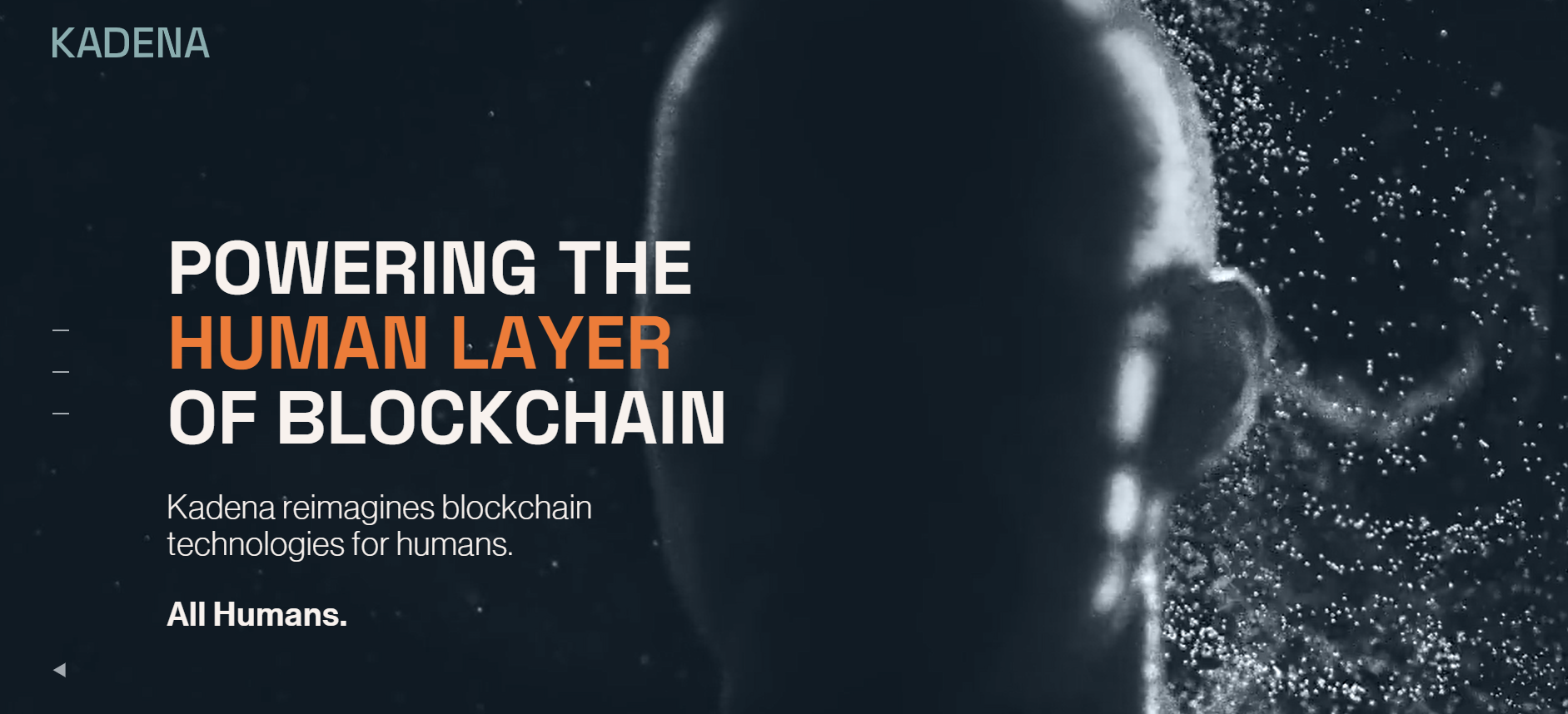
What is Kadena?
Public Blockchain (Chain Web) uses a parallel Proof of Work consensus mechanism to improve throughput and scalability while maintaining security and integrity like Bitcoin. Thanks to this feature, the project team estimates Kadena is capable of processing up to 480,000 transactions per second, which is quite impressive performance. Private Blockchain (Kuro) is Kadena’s private Blockchain aimed at businesses or financial institutions.
The current Public Blockchain uses up to 19 Web Chains (possibly more scalable) operating in parallel, all chains are peer-to-peer and all chains are developed with the same consensus mechanism. These chains complement each other to run concurrently as well as divide large loads and calculations. By sharing data through the Merkle Tree data structure to achieve cross-chain consensus.
The Kadena team emphasizes that these chains are absolutely not Side Chains and they also do not have a Main Chain.
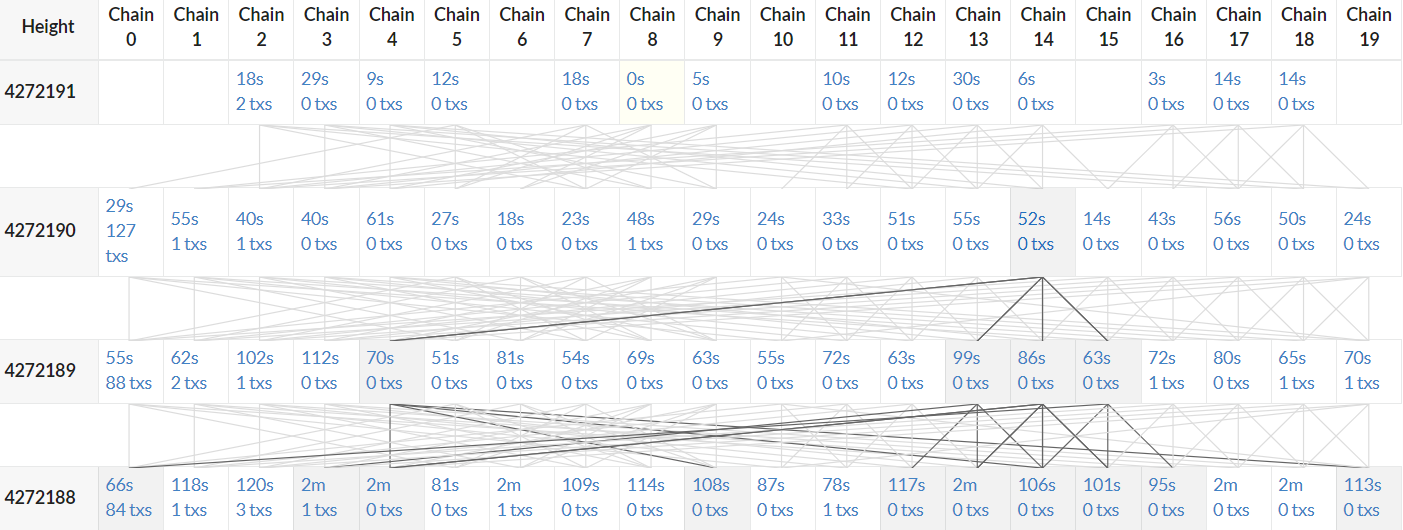
ChainWeb Kadena
The Smart Contract Pact language was created by the Kadena team for Private Blockchains and the team shares that it is more convenient than Ethereum’s Solidity. It helps Developers program more safely and quickly with automatic error detection, eliminating complex processes, making it easier for Developers to control and avoid Hacker attacks through various methods. that hole.
Hashrate parameters
With a focus on using the PoW mechanism to improve security and decentralization. Kadena’s hashrate rate and rewards for miners are parameters that deserve top attention. A simple explanation of hashrate, it reflects the mining performance of mining hardware and is measured in seconds.
Each solution performed on the network is called a hash. That mining efficiency is measured in h/s. The parameters are converted similarly to the following:
- 1 Kh/s = 1 000 h/s
- 1 Mh/s = 1 000 Kh/s = 1 000 000 h/s
- 1 Gh/s = 1 000 Mh/s = 1 000 000 Kh/s = 1 000 000 000 h/s
- 1 Th/s = 1 000 Gh/s = 1 000 000 Mh/s = 1 000 000 000 Kh/s = 1 000 000 000 000 h/s
- 1 Eh/s = 1 000 Ph/s = 1 000 000 Th/s
Solution roughly translated as calculation solutions or algorithmic solutions. A GPU or mining device has different computing parameters. From there, Miners or Users can consider and build suitable, high-performance equipment to participate in the mining network to earn profits. For small individuals, we can preview mining profits with the number of available devices through the calculation website 2CryptoCalc or Whattomine.
Kadena uses the Blake2s algorithm. This is an algorithm that has a cryptographic hash function that is faster than MD5, SHA-1, SHA-2, and SHA-3. It is used by many projects due to its high speed, security and simplicity. Along with that is compatibility with operating systems from 8 to 32 bit or 64 bit.
As of 2023, KDA has a few on-chain parameters as follows:
- Network hashrate: 446.32 PH/s
- Network difficulty: 669.48 P
- Block reward: 1,024 KDA
- Block time: 1.5 Sec
- Daily emission: 58982 KDA
- Return 1 Mh/s: 0.132 KDA
Everyone can refer to hashrate.no or ethwmine to update hash rate in the fastest and most accurate way.
Notable features
Kadena is the only platform that provides a complete decentralized infrastructure for Developers. Combining groundbreaking Blockchain architecture with tools for widespread adoption, serving Developers with full features such as:
- Proven security: The experiences of Kadena’s founders at JPMorgan have revealed the limitations of existing blockchain solutions. To address the security and throughput needs of financial services customers, Kadena runs on Proof of Work, a trusted, secure and highly resilient solution.
- Safer smart contracts: Pact makes it easier to design secure smart contracts, whether you’re writing your first contract or launching your 50th dApp. By automatically detecting errors, Pact helps developers escape exploits that will be encountered on Ethereum and other insecure platforms.
- No-cost transactions: While the team offers minimal transaction fees to users, the team has gone a step further in introducing the first gas station that allows businesses to eliminate all transaction fees for their customers. them, thereby removing the main barrier to mass adoption of dApps.
- Industrial scalability: Unlike other platforms, Kadena is designed to support the global financial system. Its protocol is continuously scaling higher TPS (Transactions Per Second) as more Chains are added to the network.
- Energy efficient at scale: As network demand increases, Kadena’s energy usage remains constant. Its unique architecture makes it the only platform that can deliver higher energy efficiency at TPS (Transactions Per Second) scale.
Kadena Ecosystem
Kadena’s ecosystem is gradually developing with a full set of backbones such as Defi, Custody, Gaming, NFT, Tools, infrastructure and applications for businesses.
Currently, there are about 55 Projects operating on the network. In the future, there will be many Smart Contracts created, and new projects joining the ecosystem. Because previously, in early 2022, the Kadena team announced the launch of a $100 million funding program for Builders. Everyone can refer to Kadena Ecosystem to learn more about each Project.
Essentially a mining coin, the Defi segment is not Kadena’s strength as the current TLV number is quite bad, from the beginning of 2022 to the end of 2025 there are only 3 Dexes platforms, 1 Launchpad platform. In addition to eckoDAO, which has the number of users to count on the fingers of one hand, the remaining platforms have no users at all.
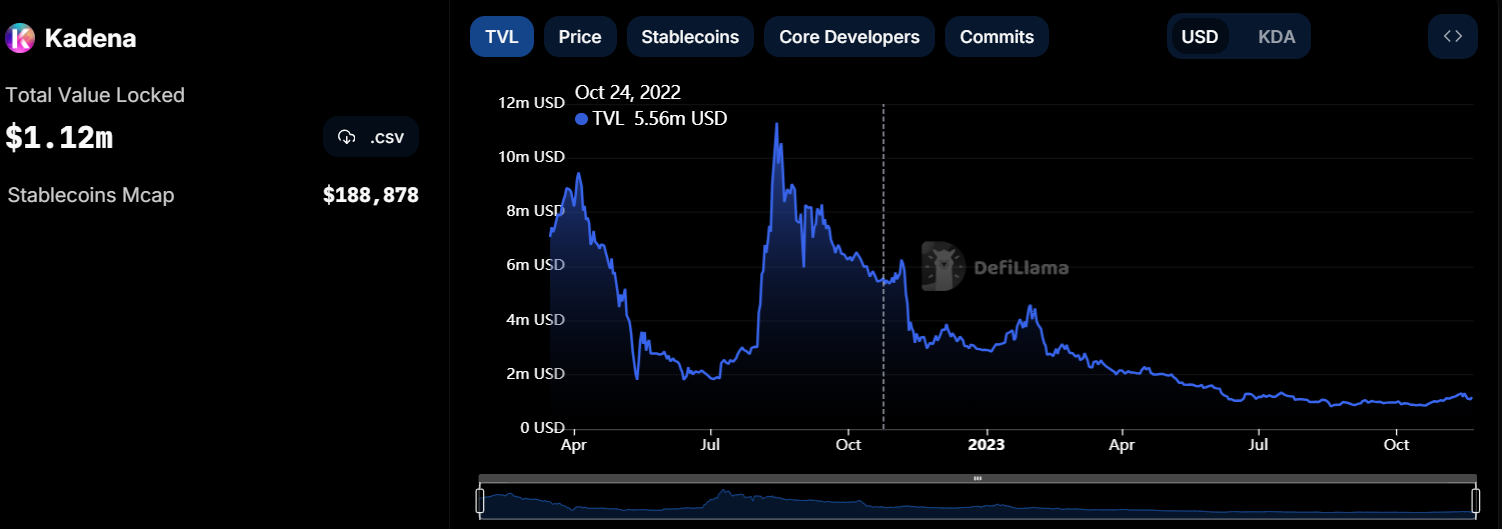
TVL Kadena
Development Roadmap
As we enter 2023, the Kadena team will narrow its ecosystem development focus through technical developments such as refining the builder onboarding process and improving the efficiency of the KDA Blockchain. As a result, the Team has updated its live roadmap to identify key areas of technical development that will greatly benefit the builders community and the entire KDA ecosystem as a whole. The upgrade roadmap will include:
- Kadena.js: New tools, resources, tutorials, and learning platforms to enhance and enhance the developer onboarding experience.
- Pact: Upgrade to Kadena smart contract language to improve user and Builders experience.
- Chainweb: Upgrade Chainweb to improve blockchain efficiency, scalability, and decentralization.
Kadena 2023’s live roadmap aims to accelerate user and ecosystem growth and will continuously evolve throughout the year.
Moving forward to 2024, the team invites its community or anyone else to participate, as well as give feedback or suggestions on how Kadena should develop through social media channels.
It seems that the vision of bringing Kadena to develop strongly and reach out to the world to reach businesses is gradually becoming more difficult than ever when the team itself does not know what to do next in the long term.
Core Team
Kadena’s human resources team is especially high-quality with people who have worked at large businesses such as JP Morgan, Apple, SEC, Microsoft, Disney. Core members include:
Founder & CEO: Stuart Popejoy

- He manages JP Morgan’s emerging Blockchain technology team.
- He has 15 years of experience building trading and exchange systems for the financial industry.
- In 1999, he researched the design and construction of an internal SFA system, making major improvements to the C++-based CMS.
- In 2007, he researched, built, maintained and directed the development of algorithmic trading software, smart order routing, FIX connectivity and messaging solutions at Pragma Securities.
- Since 2016, he founded Kadena and together with the team has developed the project until now.
Co-Founder & President: Will Martino

- You are Full-time Haskell Engineer in the Emerging Technologies team in Corporate and Investment Banking. Lead engineer for the Emerging Technologies open source Juno project at JP Morgan.
- He also served as a senior advisor to the US Securities and Exchange Commission, evaluating and highlighting the risks and potential areas of financial market manipulation.
- Then he and Stuart founded Kadena.
Chief Technology Officer: John Wiegley

- He started his career as a front-ends developer and has worked in the C++ programming community for nearly 25 years.
- In 2014, he was a senior chief engineer at BAE Systems Information Technology, researching mainly on DARPA-funded projects.
- He served as the chief engineer of DFINITY (ICP) tasked with verifying the ICP blockchain consensus layers and their implementation.
- By October 2022, he took on the position of Kadena’s chief technology officer, dedicating himself to the project with the extensive knowledge of Blockchain and finance he had acquired.
Investor
Through two capital calls at Series B and ICO Coinlist, Kadena raised a total of $22 million with specific Rounds as follows:
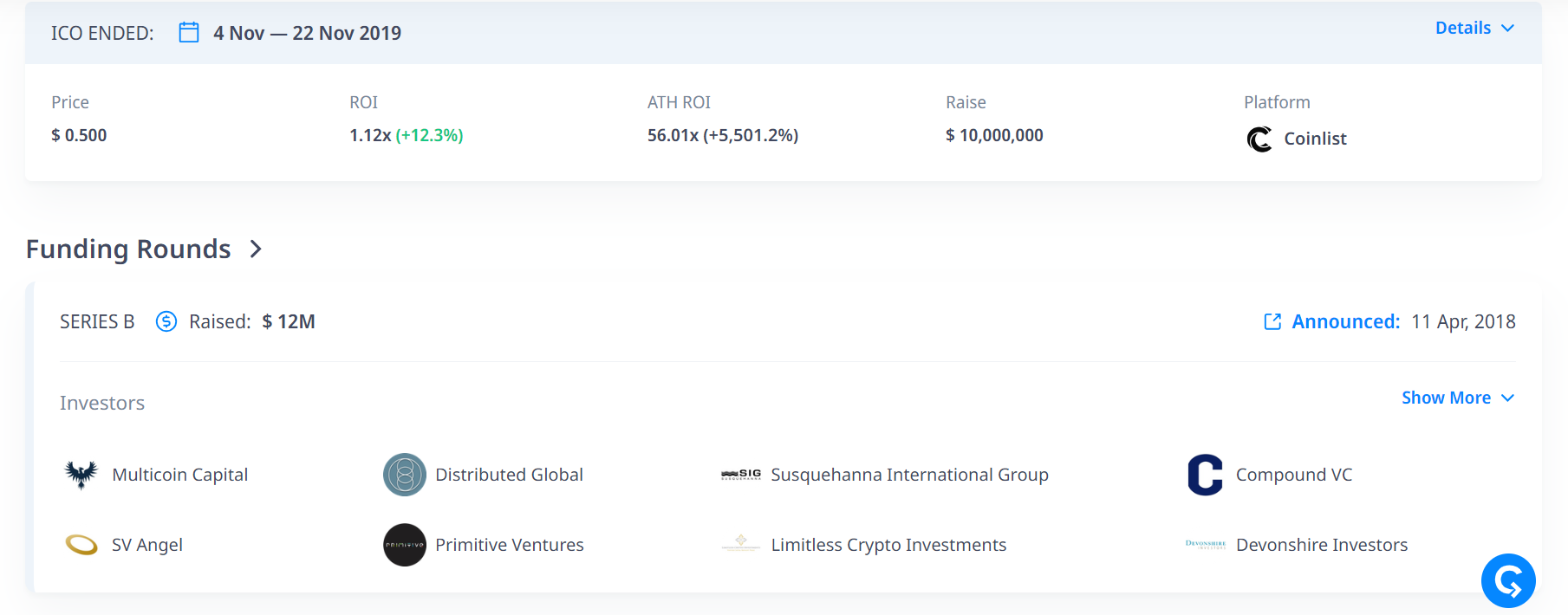
- The ICO ended on November 22, 2019 with $10 million raised for 20,000,000 tokens sold for $0.50.
- Series B raise of $12 million was announced on April 11, 2018 with famous investment funds such as Multicoin Capital, or Compound VC.
Tokenomics
Basic information about KDA token
- Token name: Kadena
- Ticker: KDA
- Blockchain: Kadena
- Standard: Native token
- Total Supply: 1,000,000,000
Token Allocation
The total supply of KDA is distributed as follows:
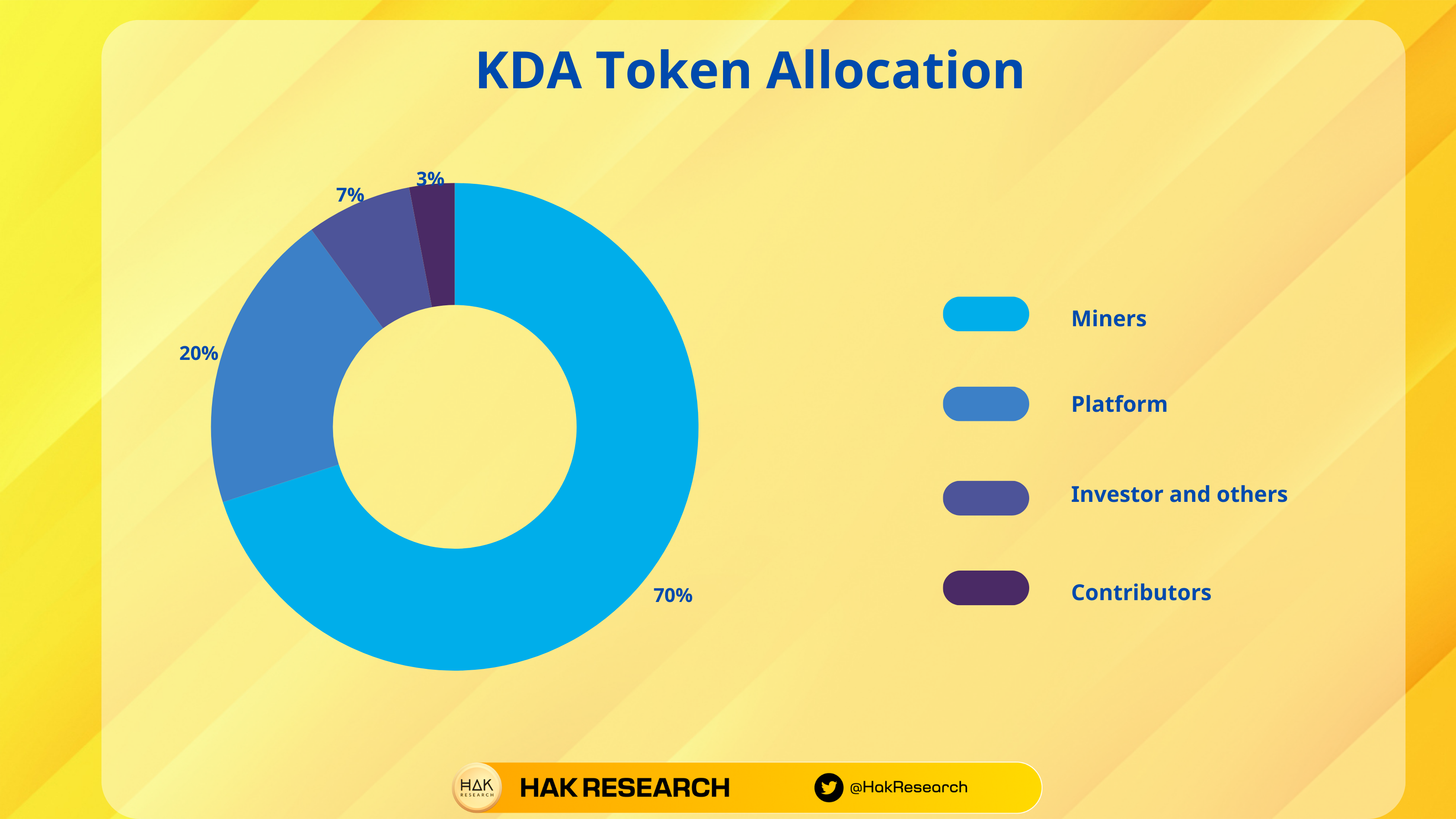
- Miners
- Platform
- Investors and others
- Contributors
Token Release
Block rewards are adjusted on a preset schedule every six months, with approximately half of the mineable coins, with the remainder released as block rewards every 20 years. Since Kadena has a fixed number of tokens, Kadena can be mined for about 120 years.
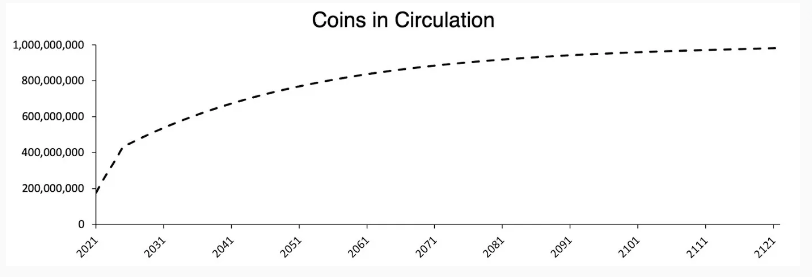
Token Use Cases
- Pay transaction gas fee.
- Participate and buy and sell on Kadena’s Dex and dApp.
- Miners are rewarded for participating in transaction validation and network security.
Exchanges
Currently KDA is present on exchanges such as: Binance, Bybit, Kucoin, Gate.io, OKX…
Kadena’s Information Channel
- Website: https://kadena.io/
- Twitter: https://twitter.com/kadena_io
- Discord:
Summary
Kadena is a quite unique PoW blockchain, with scalability that is also very convenient. However, with a vision of reaching out to the world and approaching large businesses. The Kadena project team really still needs to do a lot. However, in the context of the BTC having event approaching in April 2024, it is likely that this will be a small growth driver, when KDA will benefit a bit because of its PoW operating mechanism.


